How and with what waterproofing of sewer wells is carried out
One of the most common methods of installing a sewer system in a private home is the construction of a concrete septic tank.At the same time, not everyone wonders about its tightness.
But in vain, because properly waterproofing sewer wells will not only extend their service life, but also protect the soil from contamination. Let's figure out why you need to waterproof sewer drains and how to do it correctly.
The content of the article:
Why waterproof a sewer well?
A serious mistake is made by those who believe that they can neglect the work associated with sealing the sewer well.
At best, there will be severe contamination of groundwater, and at worst, septic tank made of concrete rings will collapse in a few years.
There are several reasons why waterproofing a well should not be neglected, these are:
- Corrosion of the reinforcing component of reinforced concrete rings. As a result of the formation of rust spots on the reinforcement elements, the bearing capacity of the well shaft, which is constantly subjected to pressure from the surrounding soil, is significantly reduced.
- Weakening the concrete walls of the shaft. Sewage and groundwater contain chemically aggressive substances that negatively affect the structure of concrete. Over time, under their influence, cavities and cracks form, leading to the destruction of concrete.
- Potential for runoff infiltration. The walls of a concrete shaft with caverns and cracks will not be able to prevent the infiltration of wastewater into the surrounding soil.Which will ultimately lead to a critical change in the ecological balance.
- Depressurization of joints. Concrete that has absorbed water will slightly increase in size during the frosty period. Visually imperceptible “movements” of concrete rings will become a serious threat to the joints of the shaft assembled from them.
- Destruction of concrete. Freezing out the binder component of concrete stone at sub-zero temperatures, especially in the zone of seasonal soil freezing, leads to rapid breakdown of bonds in the monolithic mass. For this reason, the well will last two to three times less than expected.
If everything is clear about the protective properties of waterproofing, then there is another important reason for sealing a sewer well. We are talking about floods and groundwater, the level of which becomes noticeably higher during periods of active snowmelt and heavy rains.
Flood and groundwater can cause the well to fill prematurely, because... Concrete without waterproofing can allow water to pass through. As a result, pumping will have to be carried out using special equipment.
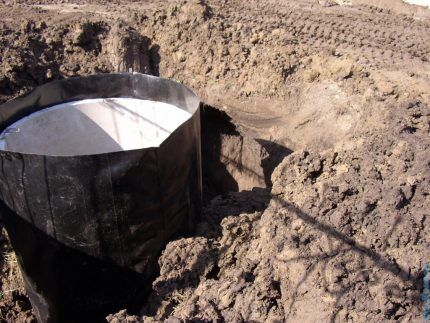
Work on insulating sewer wells can be divided into two main types:
- Internal waterproofing;
- External waterproofing.
It is recommended to simultaneously carry out internal and external waterproofing, which will maximize the protection of the well walls from erosion, and the soil and groundwater from pollution.
External insulation work
The main task of such waterproofing is to minimize or completely eliminate the contact of the external walls of the septic tank with groundwater.
It is best to carry out the work at the stage of constructing a well. If this is not done on time, then a significant amount of excavation work will subsequently have to be performed.
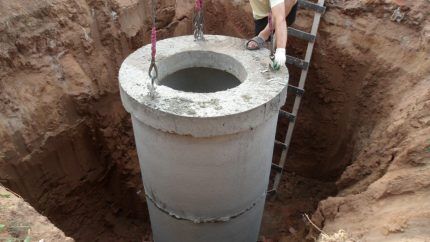
Waterproofing with bituminous materials
For external waterproofing, bitumen mastics and bitumen roll materials are used:
- A composition of 3 parts gasoline and 1 part bitumen must be applied to the cleaned and prepared surface. The mixture should be applied using a compressor by spraying, but you can also use a regular brush.
- To ensure maximum sealing of the seams, they should be taped with bentonite-rubber tape.
- After the first layer of primer has dried, it is necessary to prepare the concrete rings - repair chips and potholes until a smooth surface is obtained. To fill sinks, it is best to use a mixture of PVA glue with cement-sand mortar in a ratio of 1 to 5, but you can also use ordinary cement mortar.
- After the cement has dried, you need to apply another layer of primer from a bitumen-gasoline mixture, but in a 1 to 1 ratio.
- The next step is to apply mastic; it is better to use tar mastic, since bituminous mastic peels off easily. You can also use coating bitumen mastics with polymer additives.
- All that remains is to apply 3-4 layers of rolled materials (roofing material), carefully gluing the joints.
- Upon completion of the work, it is necessary to backfill the soil and, if necessary, install a clay castle and a concrete blind area.
The main advantage of waterproofing a well with bituminous materials is the ease of work and the low cost of the material.In this case, you should strictly adhere to the technology for performing the work, since a violation of the proportion of the bitumen-gasoline mixture can cause premature destruction of the protective layer.
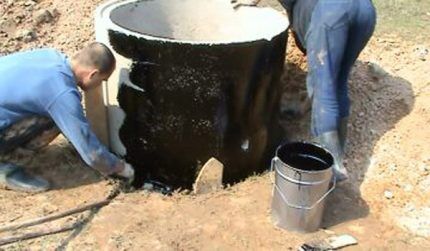
Application of penetrating impregnation
Penetrating waterproofing is a good alternative to bituminous materials. However, its use requires more thorough preparation of the concrete surface, removing all irregularities and grinding.
In this case, grinding is best done by sandblasting, which will allow the pores of the concrete to open as much as possible.
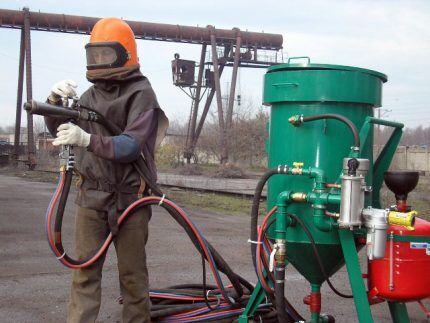
After grinding the concrete, no primer is applied. Before applying deep penetration waterproofing, it is necessary to thoroughly moisten the surface to be treated.
It is best to give preference to the proven primer “Penetron”, “Kalmatron”, “KtTron”, but you can also limit yourself to cheaper analogues such as “Elakor-PU”.
Waterproofing should be applied with a sponge or a stiff brush. The drying time of the composition is three days. At the same time, during the drying process it is necessary to moisten the surface to avoid cracking, and in hot weather it is necessary to moisten every 3-4 hours.
After the first layer has dried, another layer of waterproofing should be applied. Strokes can be made with a brush or spatula; they should be directed perpendicular to the previous strokes.It is important to ensure that during the hardening period the surface is not subjected to mechanical damage and drying out.
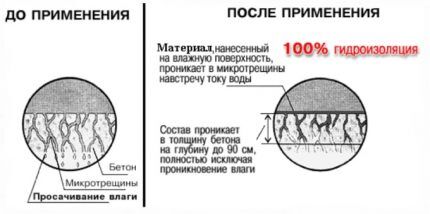
Plaster under pressure
When shotcreting with cement, the surface of concrete rings does not require preliminary preparation. Using a cement gun, which provides a minimum pressure of 4 atmospheres, a layer of cement 5-10 mm thick is applied. High pressure ensures maximum cement compaction and reduced porosity.
The cement coating requires periodic wetting (3-4 hours in hot weather and 10-12 hours in normal conditions). After 10-12 days, you need to repeat the shotcrete and apply another layer of cement.
Construction of a clay castle
If it is not possible to insulate the upper rings of the sewer well with expensive means, ordinary crumpled clay will do. The principle of protecting concrete walls is similar to the arrangement of drinking water wells with clay locks.
Only a layer of clay is placed in a narrower trench around the shaft, because there is no need to protect the drains from precipitation and flood waters.
It is best to make a clay castle in the spring in warm, dry weather. You can use clay that was extracted when constructing the well. In this case, it is necessary to remove sand impurities and remaining stones.
At the first stage, it is necessary to clear the space around the rings with a thickness of 20-25 cm to a depth of about 2 m. Initially, the resulting gap must be filled with wet and greasy clay, compacting it thoroughly.
Next, you need to remove a layer of earth 30 cm thick within a radius of 1-2 m from the wall of the ring.The resulting space must be filled layer by layer with clay, laying it in layers of 8-10 cm. Each of the laid layers must be well compacted. The resulting clay castle will minimize the contact of the outer walls of the well with flood waters and precipitation.
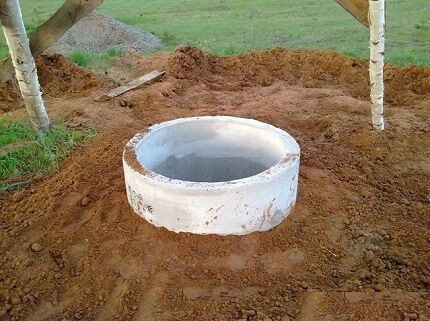
After a couple of years, when the soil has compacted and subsided as much as possible, you can begin constructing a concrete blind area. To do this, you will need to install formwork and backfill with a cement-crushed stone mixture in a ratio of 1 to 10.
The thickness of the backfill should be 0.1-0.15 m, it must be well compacted. All that remains is to prepare the concrete and pour it.
Internal waterproofing of a well
The following materials can be used for internal waterproofing:
- cement putty;
- bitumen-gasoline mastic or molten bitumen;
- cement-polymer composition;
- bitumen-polymer mixture;
- polymer waterproofing.
Internal waterproofing of a sewer well can be done shortly before its operation.
Before carrying out waterproofing work, the well must be dried. The concrete surface should be cleaned of dirt and dust and, if necessary, sanded.
Cracks, joints and crevices need to be widened to 20-30 mm, cleaned with a metal brush and sealed with a cement-polymer mixture.
Waterproofing with cement mixture
To waterproof a septic tank, it is best to use a ready-made mixture, which just needs to be diluted with water in accordance with the instructions. The resulting composition must be applied using a spatula 2-3 times so that a layer 6-8 mm thick is formed.
After applying the last layer, the surface must be moistened and the well closed with a lid. Depending on the temperature, the drying time of the waterproofing layer can be 4-5 days.
During this time, you need to open the well 3-4 times a day and wet the inner surface. The service life of cement insulation is up to 15 years.
Most often, a cement mixture is used to insulate joints before applying final waterproofing.
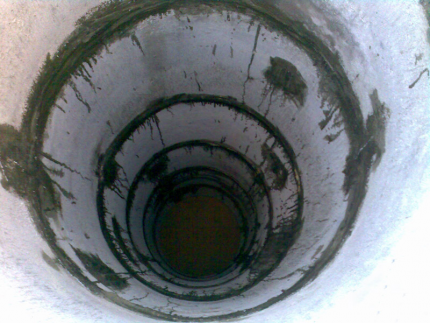
Application of bitumen-gasoline painting
The work is carried out in the same way as when installing similar external waterproofing. The mixture is applied in three layers, the hardening time of each layer is about 12 hours. This type of waterproofing is not durable, its service life does not exceed 10 years.
If, instead of bitumen-gasoline painting, two layers of bitumen mastic are applied and roll insulation is fused, the service life can be tripled. You should work as carefully as possible and ensure ventilation of the well, since surfacing inside is associated with a certain risk.
Waterproofing with cement-polymer composition
Penetrating cement-polymer mixtures are one of the most modern and effective methods of waterproofing. The mixtures from the Greek company ISOMAT have proven themselves to be the best. They are environmentally friendly and durable.
Since environmental cleanliness in a septic tank is not as important as in a well, internal waterproofing can be done with cheaper penetrating coatings “Penetron Admix” or “Penecrete”. The mixture must be applied in 3 layers using a spatula.Cement-polymer waterproofing will last at least 40 years.
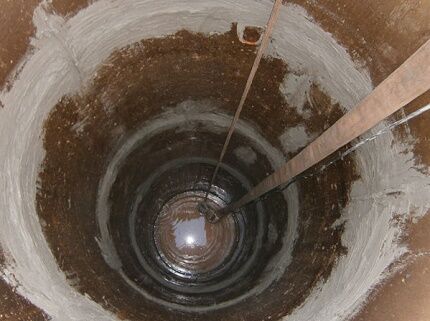
If you use a two-component mixture of CeresitCR 166 as insulation, you can increase the service life of the waterproofing layer to 60 years. The prepared mixture must be applied to a moistened concrete surface without efflorescence using a paintbrush.
On the first, not yet hardened layer, it is necessary to lay a reinforcing mesh and apply a second layer of the mixture. The two-component composition of CeresitCR 166 is highly elastic, which reduces the risk of waterproofing failure as a result of slight displacement of the rings or their deformation.
Use of polymer mixtures
This material is the most expensive, but at the same time the most effective. The use of polymer mixtures will be justified in unstable septic tanks in which deformation of the rings is observed. Maximum efficiency is ensured by high elasticity, achieved by installing the membrane on special mastics.
The film polymer membrane has proven itself best. First, the concrete rings must be treated with a special mastic and left for 24 hours. The film has an adhesive base; simply unroll the roll, press the film to the surface and smooth it to remove air bubbles. The service life of polymer membrane insulation reaches 50 years.
Application of plastic inserts
One of the most reliable and simplest ways to waterproof a sewer well is to use a multilayer polymer or plastic insert.It has the shape of a cylinder, equipped with a bottom, lid and neck. The height of the insert reaches 4.5 m, and the diameter can be 90 cm, 140 cm, 190 cm.
The wall thickness of the insert ranges from 8-25 mm depending on the manufacturer. To prevent deformation, the inserts are reinforced with stiffeners. Installation is very simple, just lower plastic insert into the well and fill the space between the walls of the insert and the concrete ring with a dry cement-sand mixture.
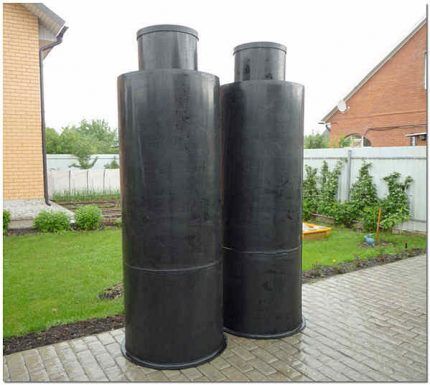
Sealing joints between concrete rings
No matter how the septic tank is waterproofed from concrete rings, it will not be able to ensure complete tightness without mandatory treatment of the joints between the rings. Even at the stage of installation work, a waterproofing and shock-absorbing gasket should be laid between the rings.
It is best to use a bentonite-rubber gasket. The bentonite clay granules present in its composition can increase their volume by 3-4 times upon contact with water. This reaction of the clay makes it possible to maximally fill the cracks and voids present between the concrete rings of the sewer well.
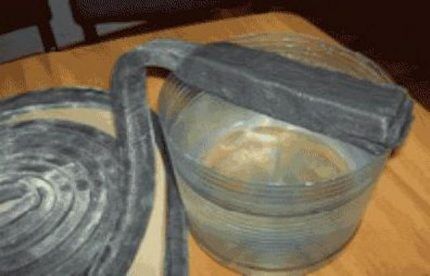
The concrete-rubber gasket has a high level of ductility. This quality allows you to maintain the tightness of the septic tank even if the concrete rings are slightly displaced. Conduct seam sealing should be done not only between the rings, but also when installing the first ring on a concrete base.
You can do it easier and instead of an expensive concrete-rubber gasket, use ordinary hemp, jute or linen ropes. The ropes themselves will not ensure the tightness of the seam, so they must be impregnated with fiber rubber. The ropes should be laid on a polymer-cement mixture, which can be replaced with a mixture of cement and PVA glue.
Conclusions and useful video on the topic
Installation of the lower ring on a slab treated with the one-component composition RABERIT:
Construction of a clay castle around a concrete trunk:
Installation of a plastic insert in a sewer shaft:
Whatever method is chosen for sewer well waterproofing, all work must be performed with maximum quality. The slightest defect can cause destruction of the insulating layer and will inevitably lead to the need for repeated waterproofing.
If you have already had to carry out work on waterproofing a sewer well on your own site, tell us which method you chose and what came out of it. Perhaps you know some nuances that need to be taken into account when carrying out waterproofing work? Please leave your comments, share tips, and ask questions in the block below the article.




We did waterproofing (internal and external) to increase the service life of the sewer well and seal it. I think you should not neglect and save on this - it may become more expensive for yourself later. All the work was carried out for us by a team that also installed the sewer well. They basically advised us to do waterproofing.We have never regretted it.
I bought a private house that already had a sewer well. Apparently, there is either something wrong with the sealing, or another problem, but the point is that with moderate use, the sewer quickly fills up, especially in the fall and spring. Then you generally need to pump it out almost every month. Tell me, is it possible to somehow solve the problems without changing the entire well from scratch?
You left quite a bit of input data to draw clear conclusions. I would like more details - how your sewer system is arranged: a sealed concrete cylinder or a septic tank with a drain.
Judging by the fact that the situation is most active in spring and autumn, the issue may well be a violation of the seal. In this case, you need to look for the leak and fix it. Most often it is a matter of improper sealing of the seams.
However, the problem may well be something else - there is a possibility that the sewer will become silted or greasy and fill the walls and bottom with organic fats. In this case, cleaning and using special biological products will help.
Hello. We had the same problem and the essence of it is that the groundwater level is higher in spring and autumn. Due to sealing problems with this problem, it fills up quickly. As a solution, install a second pit nearby for overflow. If it’s just a matter of sealing, then it won’t be possible to solve something “peacefully”.
An “eternal” plastic well is good, but nothing lasts forever. How many years will it actually last? And what are the operating conditions?
It is now reliably known that plastic rings for wells do not lose their properties after 50 years of operation. It is too early to announce a longer period, since due to the fact that the material is new, there is no practical evidence.
At the same time, concrete rings have been successfully functioning for more than 70 years; wells laid in the post-war years serve as an example of this. But concrete rings are quite heavy; the weight of one with a meter diameter and the same height is 600 kg. Which makes installation very difficult.
But plastic rings are still installed inside concrete rings, although more durable options have now appeared that do not require concrete protection. Manufacturers claim a longer service life than concrete, but time will tell, as they say.